Abstract
Download PDF
Full Article
Influence of Plasma Treatment on Mechanical Properties of Cellulose-based Fibres and Their Interfacial Interaction in Composite Systems
Petr Valášek,a,* Miroslav Müller,a and Vladimír Šleger b
The use of natural reinforcements is growing in current material engineering due to their satisfactory mechanical properties such as availability, price, and environmental aspects. Synthetic fibres are more often replaced by natural ones in many applications. The interfacial interactions of matrices are key factors that limit the use of natural fibres. The matrix interactions of natural fibres can be optimized by surface treatments, such as plasma treatment. This paper examined the possibility of using plasma to treat natural fibres. The basic mechanical characteristics of the fibres were changed by this treatment. Changes in the surface structures and the subsequent interaction with polymeric matrices with epoxy resins were evaluated by scanning electron microscopy. The plasma treatments of fibres did not decrease the tensile strength but did optimize their surface structures.
Keywords: Agave sisalana; Cocos nucifera; Musa textilis; Tensile strength
Contact information: a: Czech University of Life Sciences Prague, Faculty of Engineering, Department of Material Science and Manufacturing Technology, Kamýcká 129, 165 21, Prague 6, Czech Republic; b: Czech University of Life Sciences Prague, Faculty of Engineering, Department of Mechanical Engineering, Kamýcká 129, 165 21, Prague 6, Czech Republic;
* Corresponding author: valasekp@tf.czu.cz
INTRODUCTION
Natural fibres (generally natural fillers) are renewable resources that can often substitute for fossil fuels, which dominate the material engineering industry (Ruggiero et al. 2015; Valášek and Müller 2015; Müller et al. 2016; Ruggiero et al. 2016). Growing these fibres is nature-friendly in most cases. Ecology is the primary factor that influences the requirement for new material generation (Valášek et al. 2016). The automobile and building industry are examples where the reinforcement created by glass fibres has been successfully substituted by natural fibres (Mohanty et al. 2002). Natural vegetable fibres are often gained as a secondary product; for example, growing coconuts is connected with the co-production of coconut fibres. The utilization of these fibres is desirable, and it increases the economic return of the whole process. Natural fibres and particles are of many disadvantages, too. A water absorption belongs among significant disadvantages. A breach of the hydrogen bonding among cellulose molecules occurs at the water absorption and new hydrogen bondings with water are being created. An uncomfortable surface structure, which can be optimized by the surface treatments, is another disadvantage of natural fibres (Valášek et al. 2017).
Surface treatments of natural fibres can optimize their morphology (Mohanty et al. 2002). Surface treatments include waxing, alkali treatment, isocyanite treatment, peroxide treatment, vinyl grafting, bleaching, acetylation, and treatment with coupling agents. These processes are useful ways to improve fibre-matrix adhesion in natural fibre composites. Plasma treatment can create an interesting ecologic variant to these processes (Mohanty et al. 2002).
The utilization of oxygen plasma increases the concentration of oxygen functional groups on the surface of natural fibres (Vesel et al. 2009). The plasma can also decrease the molecule mass of lignin that is extracted from the natural fibres that have been plasma treated (Zanini et al. 2005). The lignin degradation and the fall of the cellulose content caused by the plasma treatment can influence the mechanical properties of the fibres which can show itself also by the fall of the mechanical characteristics. (Petrásek and Müller 2017).
Enciso et al. (2017) state that composites with plasma treated fibres show considerably improved tensile strengths and Young’s moduli. Gibeop et al. (2013) used an exposition of 30 s to 120 s for treating jute fibres. The jute surface treatment increased the tensile strength, flexural strength, and a tensile modulus of the composite by 20%. However, the plasma treatment of natural fibres decreases their tensile characteristics (Huh et al. 2012). The roughening of the surface occurs simultaneously, which influences the interfacial interactions with polymers.
The influence of plasma treatment on natural fibres used in composite systems is an emergent topic. Plasma treatment influences the tensile characteristics of fibres and their mutual interfacial interaction. Plasma treatments are evaluated very positively compared with other methods (Scalici et al. 2016; Sun 2016). The length of the exposition is an important aspect. The tensile characteristics of the natural fibres themselves are often considered, e.g., their shape is not clearly circular, a cross-section is loaded with pores (lumens), fibres do not show the same areas of the cross-section, etc. (Tran et al. 2015). Determining the tensile characteristics and prospective defining of the treatment influence on their change is key for modelling fibre composite systems.
This paper describes the influence of the plasma treatment on fibers from plants grown in tropical and sub-tropical areas on the mechanical properties of these fibres. The main aim of presented paper was to describe interfacial interactions between natural fibres and an epoxy resin by means of an electron microscopy. Further, the electron microscopy was used for a description of changes on the surface of natural fibres caused by the use of oxygen plasma. Further, this paper describes tensile characteristics related to the circular cross-section of the fibres. This methodology was chosen to interpret the results; most characteristics of natural fibres are calculated just to the circular cross-section. Three different fibres (coconut coir, banana, and sisal fibres) were treated under constant conditions. The same conditions of the surface treatments were kept due to easier interpretation of results for each particular type of fibres. This experiment focuses on a short plasma treatment (30 s) at high discharge power (350 W) in order to minimize the reduction of the strength characteristics of these fibres. This paper does not judge the influence of various discharge powers and times on mechanical properties. However, it compares concrete parameters on various types of natural vegetable fibres.
EXPERIMENTAL
Fibres of Plants Evaluated in the Experiment
Cocos nucifera is a palm that grows in tropical areas. The primary reason for the planting of this palm species is the gathering of fruits (seeds), i.e., coconuts. Fibres (coir, a secondary product) are gained during processing the fruits from a pericarp. Fibres obtained as a co-product during processing coconuts in the Philippines were used in the experiment. The cellulose, hemicellulose, pectin, and lignin contents are 46%, 0.3%, 4%, and 45%, respectively (Jawaid and Abdul Khalil 2011; Yan et al. 2016).
Musa textilis plant leaves produce abaca fibres up to 6 m long, which consist of 62.5% cellulose, 21% hemicellulose, and 12% lignin (wax 3%, pectin 0.8%) (Jawaid and Abdul Khalil 2011; Yan et al. 2016). Fibres grown in the Philippines were used in the experiment.
Agave sisalana leaves produce sisal fibres. This fibre is made of ca. 60% cellulose (11.5% hemicellulose), 8% lignin, and 1.2% pectin; and the other contents are water, wax, and ash (Jawaid and Abdul Khalil 2011; da Costa et al. 2015; Yan et al. 2016). Fibres grown in China were used in the experiment.
Plasma treatment
Nowadays, plasma treatments are used for treating of synthetic fibres, as well as fibres obtained from natural materials – e.g. coir is obtained by means of a set of counter-rotating rollers – removing of the fibre from the coconut, i.e. a pectin packaging. Plasma was generated from a plasma generator based on Diffuse Coplanar Surface Barrier Discharge (Plasma Reactor KPR 200 mm RM 54, Gronau (Westf.), Germany; Fig. 1) while supplying the reaction gas (oxygen) and maintaining the reactor pressure at 0.1 Torr with a vacuum pump. The electrodes are powered by high-voltage sources of a frequency min. 15 kHz, a voltage of the high-voltage source for the electrodes min. 10 kV, and a volume density of the plasma min. 80 W·cm-3. A diffusive coplanar surface barrier discharge is the plasma source, and the electrode distance is 0.5 mm.
Fibres were placed on an active double-sided area of the plasma of dimensions 200 x 800 mm at the treatment (see Fig. 1 – b). To determine the properties that depend on the discharge power and the treatment time, the plasma treatment was conducted in the power range of 350 W for 30 s. The parameter corresponding to the bottom power of the plasma electrode was chosen from adjustable parameters, so 350 W. A short time (30 s) was used so that it would not influence the strength characteristics. Pizzi et al. (2009) established that the surface of natural fibres was influenced by already short affecting of the plasma. Huh et al. (2012) found the reduced tensile strength of fibres with increasing exposure time. A higher discharge power was chosen for a quick but intensive treatment of the fibre surface.

Fig. 1. A) Preparation of fibres for experiment; B) plasma treatment
Scanning electron microscopy
An electron microscope (Tescan Mira 3 GXM, Tescan Brno, s.r.o. – Brno, Czech Republic) equipped with an energy dispersive X-ray was used for a description of the fibre morphology, a definition of the dimension, and an evaluation of the interfacial interaction. Fibres were coated with gold (Quorum Q150R ES) before being placed into a vacuum chamber.
Mechanical characteristics of fibres
The tensile strength and the elongation at break were determined for each fibre. The values of the strength before and after the plasma treatment at various lengths of fibres (10 mm to 50 mm) were compared. The hypothesis H0 was introduced for a statistical comparison. Its validity indicated a statistically insignificant difference in the strengths among compared sets. A universal testing machine (LabTest 5.50ST 50 kN, Opava, Czech Republic) was used for the determination of the tensile characteristics of the fibres, following a modification of the standard ASTM C1557-14 (2014). Observed characteristics were determined for various lengths of the fibres at 10 mm, 20 mm, and 50 mm. Fibres were clamped into the jaws of the testing machine with paper templates measured at 200 g/m2 (Fig. 2). These templates are commonly used to clamp natural fibres (Alves Fidelis et al. 2013; Ren et al. 2014). These templates accurately measured the required fibre length, which the clamp required to keep the fibres from slipping in the jaws. A shift speed corresponded to 1 mm·min-1.

Fig. 2. Template for fibre fixing (10 mm)
Preparation of test samples for evaluation of interfacial interaction – SEM
Test samples for the evaluation of the interaction of fibres and the epoxy resin were prepared by wetting them with the epoxy resin. A low-molecular epoxy resin, Glue Epox Rapid prepared from bisphenol A and epichlorhydrin, was used. Its molecular weight was < 700 g·mol-1. It is distinguished for high liquidity and increased hardening speed. This resin shows perfect adhesive properties for many materials. The fibres were dried at the temperature 105 °C before the application. The test samples were broken by the tensile loading and the interfacial interaction was evaluated on the fracture surfaces. The shape of the test samples corresponded to the standard CSN EN ISO 3167 (2004).
RESULTS AND DISCUSSION
A growth of natural fibres creates differences between the fibre structure and the fibre surface structure itself. Treatments of the fibre surface can be marked as the most used way of affecting the surface units on the fibre surface which is key in terms of the interfacial interaction in the composite systems. The first step in measuring the influence of the plasma treatment on the vegetable fibres was comparing the fibre morphology before and after the plasma surface treatment. The influence of the plasma on the surface structures of the fibres was measured for all vegetable fibres. Action of the plasma causes a fission of the surface molecules and a networking of the surface molecules.
Figure 3 presents an example of a fibre that was treated from one side only. Figures 4 and 5 generally describe the surface of the fibres before and after the plasma treatment at the given discharge power of 350 W and the exposure time of 30 s.
The plasma treatment of the fibres demonstrably removed surface waxy layers, which are typical for natural vegetable fibres and cause unfavourable interactions with the polymeric matrices. With the use of oxygen plasma, the concentration of oxygen functional groups are created on the surface of fibres. The plasma decreases the cellulose content and it comes to the lignin degradation in the surface layers of the fibre. The hardness (a regular segmentation) increase occurred for all reviewed natural fibres owing to the removal of surface layers. These observations (Figs. 4 and 5) are in accordance with the conclusions following from the studies of Sood et al. (2015), which state that the fibre roughness increases with the right treatment of the natural fibres. The results correspond to conclusions of Huh et al. (2012), who also roughened the surface of natural fibres by the plasma treatment; and they state the optimal time is 30 s for jute fibres at 40 W. The plasma effect led to coarsening of the fibre morphology (Sinha and Panigrahi 2009).
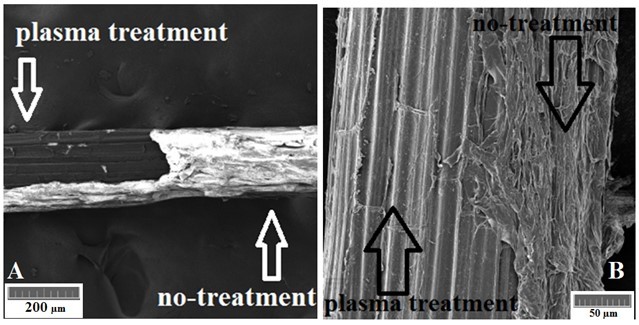
Fig. 3. A) Influence of one-sided exposure of fibre to plasma treatment; B) comparison of treated and untreated side of abaca fibre: Mag. 310x (left), Mag. 581x
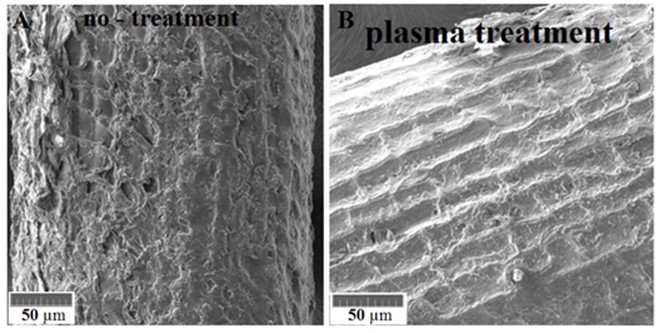
Fig. 4. A) Untreated coconut fibre; B) plasma treated fibre

Fig. 5. A) Untreated sisal fibre; B) plasma treated fibre
Another aspect of judging the influence of the plasma treatment of the fibres is evaluating the influence of the fibre treatment on the interfacial interaction with commonly used matrices, such as epoxy resin. The interfacial interaction between used resin and the plasma is influenced by the increasing concentration and by the creation of new oxygen functional groups on the surface of fibres. The analysis performed using the electron microscope confirmed the optimization of interfacial interactions for all types of fibres (Figs. 6 to 8).
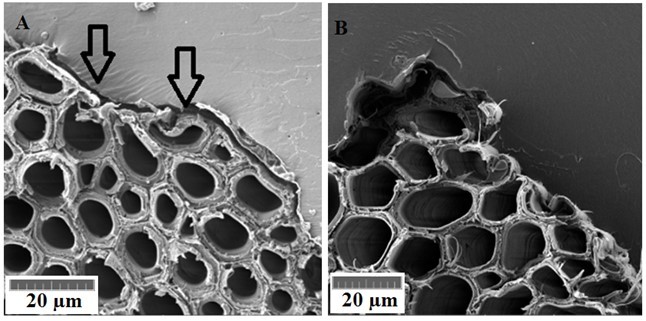
Fig. 6. Interfacial interaction in (A) untreated and (B) plasma treated abaca fibre
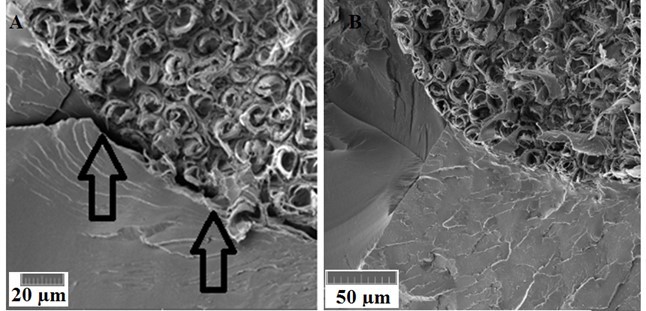
Fig. 7. Interfacial interaction in (A) untreated and (B) plasma treated coconut fibre
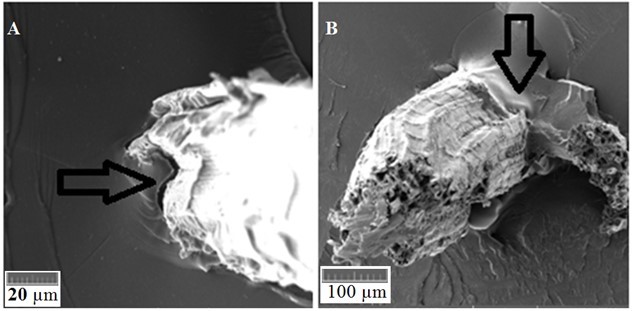
Fig. 8. Interfacial interaction in (A) untreated and (B) plasma treated sisal fibre
As shown in Figs. 6 to 8, natural vegetable fibres are created from elementary fibres with a lumen. The structure of the fibre cross-section is not purely circular. All fibres showed great differences in the cross-section area. This paper evaluated tensile characteristics related to the circular cross-section, which is a commonly used process. However, there are a number of studies, e.g. Noda et al. (2016), shifting the calculation to the real shape of the cross-section of the fibres when unfilled parts of the fibres (the porosity of the fibre) are regarded in the calculation. Coconut fibres have 22 to 30% porosity (Tran et al. 2015).
The diameter of each fibre was measured to judge the tensile characteristics, namely that way that the diameter was measured in three different places after clamping the fibres into the template. The tensile strength was calculated using the average of these values. The histograms in Fig. 9 show the diameter of the fibres used in the experiment. These data summarize the diameter of the fibres as one of the factors that influences their mechanical characteristics, and it is determined to some extent by the conditions of the growth of the plant source of the fibres. The fibre diameters reached the dispersion expressed as the variation coefficient: 29% (sisal), 37% (coconut), and 34% (abaca).
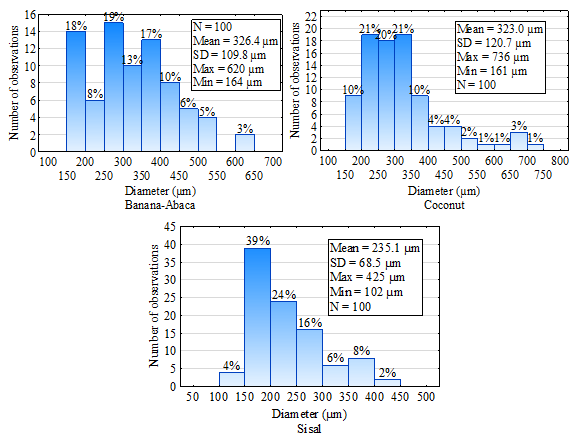
Fig. 9. Histograms of average values of diameters of single fibres
There was not a significant change in the tensile strength values of untreated and plasma treated fibres (350 W for 30 s). As shown in Table 1, sisal fibres did not reach the length of 50 mm needed for the evaluation of the tensile strength. These conclusions are not in accordance with Huh et al. (2012), who observed decreased tensile strength of natural fibres (jute) at 30 to 120 s and 40 to 100 W. However, another type of the plasma reactor was used (cylinder 0 to 90 mTorr), and the decreased tensile strength values were not observed at 40 W and 30 s only. There was an insignificant increase in tensile strength compared with the untreated fibre.
Table 1. Statistical Comparison of Fibres with and without Plasma Treatment

There was not a uniform trend in strength change for a single fibre type in response to the fibre length. The elongation values decreased with the fibre length identically for all types of natural vegetable fibres. There were great differences in the measured values compared with previously published results, which reflects the natural character of the fibres. The highest strength of abaca fibres was reached at the length 20 mm (untreated), 356 ± 194 MPa on average (maximum measured value, 853 MPa; Fig. 10). The maximum elongation corresponded to 6.7 ± 2.3% (untreated 10 mm). This value decreased with increasing fibre length up to the value 2.6 ± 0.6%. These values were smaller than the results of Mekel et al. (2016) who observed an average strength of abaca fibres of 541 MPa (mean length of the fibres 0.151 mm).

Fig. 10. Banana fibre – abaca: tensile strength (left), elongation at break (right)
The maximum average tensile strength of coconut fibres of 113 ± 47 MPa was reached for 20 mm plasma-treated fibres (Fig. 11); the maximum measured value was 185 MPa. These values are in accordance with the intervals stated by Toledo Filho et al. (2005) of 108 to 252 MPa (fibre diameter of 0.11 to 0.53 mm) or Munawar et al. (2007) with values of 137 ± 11 MPa (fibre diameter of 0.120 ± 0.005 mm). The elongation at break decreased from 63.9 ± 28.9% (treated, 10 mm) to 21.6 ± 10.1% (untreated, 50 mm). The elongation of the plasma treated fibres for 10 mm fibres was higher than the interval 14 to 41% stated by Toledo Filho et al. (2005). However, it is in accordance with the conclusions of Ramakrishna and Sundararajan (2005), who state up to 75% and the tensile strength of 15 to 327 MPa.
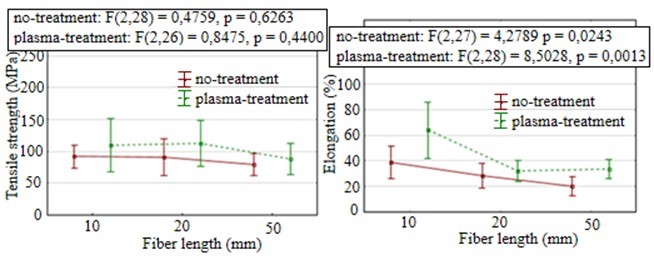
Fig. 11. Coconut fibre: tensile strength (left), elongation at break (right)
The tensile strength of sisal fibres reached the highest average value of 354 MPa for untreated, 10 mm fibres (Fig. 12). Mukherjee and Satyanarayana (1984) reported that the strength of the sisal fibres is 453 ± 92 MPa and the elongation is 5.5 ± 2.0% when the diameter is 0.250 ± 0.032 mm.
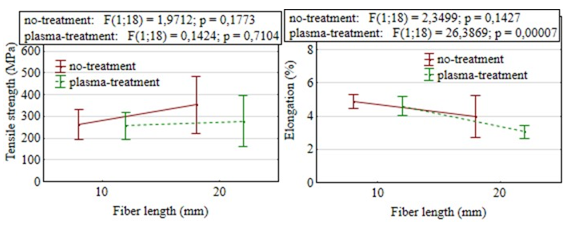
Fig. 12. Sisal fibre: tensile strength (left), elongation at break (right)
This experiment showed the adaptability of natural fibres used in composite systems. The utilization of these fibres has been described by others (Bledzki et al. 2007; Mekel et al. 2016), who state that these fibres are also suitable for the interaction with the matrices based on biopolymers such as cellulosic plastics except for classic reactoplastics matrices. The results of the experiment can be used for solving this issue. Plasma is an ecological and effective instrument for treating natural fibres. Another possibility of the plasma utilization can be the reaction with other stuffs – e.g. depositing of other substances on the surface of the fibres if necessary.
CONCLUSIONS
- Treating of fibres by the plasma led to the change of the fibre surface structures by etching (removal of surface layers). This change was confirmed by the electron microscopy, which revealed increases of the fibre roughness.
- The plasma acting increased the number of new oxygen functional groups on the surface of the fibres, which led to the optimization of the interfacial interaction with the used epoxy resin. The electron microscopy established the optimization of the interfacial interaction of the epoxy resin on the plasma treated fibres.
- The statistical comparison of the tensile strength values of the untreated and the plasma treated fibres did not prove a statistically significant change of the strength (p>0.07). Great dispersions caused by the natural character of the fibres itself are reflected in the statistical comparison.
ACKNOWLEDGMENTS
This paper was supported by grants IGA TF CZU 2017:31140/1312/3113 and 2017:31140/1312/3115
REFERENCES CITED
Alves Fidelis, M. E., Pereira, T. V. C., Gomes, O. D. F. M., De Andrade Silva, F., and Toledo Filho, R. D. (2013). “The effect of fiber morphology on the tensile strength of natural fibers, Journal of Materials Research and Technology 2(2) 149-157. DOI: 10.1016/j.jmrt.2013.02.003
ASTM C1557-14 (2014). “Standard test method for tensile strength and Young´s modulus of fibers, ASTM International, West Conshohocken, USA.
Bledzki, A. K., Mamun, A. A., and Faruk, O. (2007). “Abaca fibre reinforced PP composites and comparison with jute and flax fibre PP composites,” eXPRESS Polym. Lett. 1, 755-762. DOI: 10.3144/expresspolymlett.2007.104
CSN EN ISO 3167 (2004). “Plastics – Multipurpose test specimens,” Czech normalization institute, Prague, Czech Republic.
da Costa, D. S., da Silva Souza, J. A., da Silva Costa, D., and de Oliveira, P. S. (2015). “Characterization of sisal fibers for use as reinforcement in polymer composites,” International Journal of Engineering and Innovative Technology (IJEIT) 4(8) 70-75.
Enciso, B., Abenojar, J., and Martínez, M. A. (2017). “Cellulose. Influence of plasma treatment on the adhesion between a polymeric matrix and natural fibre,” Cellulose 24(4) 1-11. DOI: 10.1007/s10570-017-1209-x
Gibeop, N., Lee, D. W., Prasad, C. V., Toru, F., Kim, B. S., and Song, J. I. (2013). “Effect of plasma treatment on mechanical properties of jute fiber/poly (lactic acid) biodegradable composites,” Advanced Composite Materials 22(6) 389-399. DOI: doi.org/10.1080/09243046.2013.843814
Huh, Y. I., Bismark, M., Kim, S., Lee, H. K., and Nah, C. (2012). “Effects of plasma treatment on mechanical properties of jute fibers and their composites with polypropylene,” Elastomers and Composites 47(4) 310-317. DOI: 10.7473/EC.2012.47.4.310
Jawaid, M., and Abdul Khalil, H. P. S. (2011). “Cellulosic/synthetic fibre reinforced polymer hybrid composites: A review,” Carbohydrate Polymers. 86, 1-18. DOI: doi.org/10.1016/j.carbpol.2011.04.043
Mekel, A. N., Soenoko, R., Suprapto, W., and Purnowidodo, A. (2016). “Tensile strength of abaca strands from Sangihe Talaud islands,” ARPN Journal of Engineering and Applied Sciences 11(15) 1819-6608.
Mohanty, A. K., Misra, M., and Drzal, L. T. (2002). “Sustainable bio-composites from renewable resources: Opportunities and challenges in the green materials world,” Journal of Polymers and the Environment 10(1-2) 19-26. DOI: 10.1023/A:1021013921916
Mukherjee, P. S., and Satyanarayana, K. G. (1984). “Structure and properties of some vegetable fibers – Part 1 Sisal fibre,” Journal of Materials Science 19, 3925-3934. DOI: 10.1007/BF00980755
Munawar, S. S., Umemura, K., and Kawai, S. (2007). “Characterization of the morphological, physical, and mechanical properties of seven nonwood plant fiber bundles,” Journal of Wood Science 53(2) 108-113. DOI: 10.1007/s10086-006-0836-x
Müller, M., Valášek, P., and Ruggiero, A. (2016). “Strength characteristics of untreated short-fibre composites from the plant Ensete ventricosum,” BioResources 12(1) 255-269. DOI: 10.15376/biores.12.1.255-269
Noda, J., Terasaki, Y., Nitta, Y., and Goda, K. (2016). “Tensile properties of natural fibers with variation in cross-sectional area,” Advanced Composite Materials 25(3) 253-269. doi.org/10.1080/09243046.2014.985421
Petrásek, S., and Müller, M. (2017). “Mechanical qualities of adhesive bonds reinforced with biological fabric treated by plasma,” Agronomy Research 15(S1), 1170-1181.
Pizzi, A., Kueny, R., Lecoanet, F., Massetau, B., Carpentier, D., Krebs, A., Loiseau, F., Molina, S., and Ragoubi, M. (2009). “High resin content natural matrix–natural fibre biocomposites,” Industrial Crops and Products 30(2) 235-240. DOI: 10.1016/j.indcrop.2009.03.013
Ramakrishna, G., and Sundararajan, T. (2005). “Studies on the durability of natural fibres and the effect of corroded fibres on the strength of mortar,” Cement and Concrete Composites 27(5) 575-582. DOI: 10.1016/j.cemconcomp.2004.09.008
Ren, D., Yu, Z., Li, W., Wang, H., and Yu, Y. (2014). “The effect of ages on the tensile mechanical properties of elementary fibers extracted from two sympodial bamboo species,” Industrial Crops and Products 62, 94-99. DOI: 10.1016/j.indcrop.2014.08.014
Ruggiero, A., Valášek, P., and Müller, M. (2016). “Exploitation of waste date seeds of Phoenix dactylifera in form of polymeric particle biocomposite: Investigation on adhesion, cohesion and wear,” Composites Part B: Engineering 104(1) 9-16. DOI: 10.1016/j.compositesb.2016.08.014
Ruggiero, A., Merola, M., Carlone, P., and Archodoulaki, V. M. (2015). “Tribo-mechanical characterization of reinforced epoxy resin under dry and lubricated contact conditions,” Composites Part B: Engineering 79, 595-603. DOI: 10.1016/j.compositesb.2015.05.015
Scalici, T., Fiore, V., and Valenza, A. (2016). “Effect of plasma treatment on the properties of Arundo donax L. leaf fibres and its bio-based epoxy composites: A preliminary study,” Composites Part B: Engineering 94, 167-175. DOI: 10.1016/j.compositesb.2016.03.053
Sinha, E., and Panigrahi, S. (2009). “Effect of plasma treatment on structure, wettability of jute fiber and flexural strength of its composite,” Journal of Composite Materials 43(17) 1791-1802. DOI: 10.1177/0021998309338078
Sood, M., Dharmpal, D., and Guptac, V. K. (2015). “Effect of fiber chemical treatment on mechanical properties of sisal fiber/recycled HDPE composite,” Materials Today: Proceedings 2, 3149-3155. DOI: 10.1016/j.matpr.2015.07.103
Sun, D. (2016). “Surface modification of natural fibers using plasma treatment,” Biodegradable Green Composites 18-39. DOI: 10.1002/9781118911068.ch2
Tran, L. Q. N., Nguyen, T. M., Fuentes Rojas, C., Chi, T. T., Van Vuure, A. A., and Verpoest, I. (2015). “Investigation of microstructure and tensile properties of porous natural coir fibre for use in composite materials,” Industrial Crops and Products 65, 437-445. DOI: 10.1016/j.indcrop.2014.10.064
Toledo Filho, R. D., Ghavami, K., Sanjuán, M. A., and England, G. L. (2005). “Free, restrained and drying shrinkage of cement mortar composites reinforced with vegetable fibres,” Cement and Concrete Composites 27(5) 537-546.
Valášek, P., Ruggiero, A., and Müller, M. (2017). “Experimental description of strength and tribological characteristic of EFB oil palm fibres/epoxy composites with technologically undemanding preparation,” Composites Part B: Engineering 122, 79-88. DOI: 10.1016/j.compositesb.2017.04.014
Valášek, P., Müller, M., and Ruggiero, A. (2016). “Material utilization of waste originating during processing of plant Jatropha curcas L. in biocomposites-adhesive-cohesive characteristics and wear,” Technicki Vjestnik 23(5) 1411-1416. DOI: 10.17559/TV-20150430095442
Valášek, P., and Müller, M. (2015). “Abrasive wear in three-phase waste-based polymeric particle composites,” Technicki Vjestnik 22(2) 257-262. DOI: 10.17559/TV-20130905190904
Vesel, A., Mozetic, M., Strnad, S., Peršin, Z., Stana-Kleinschek, K., and Hauptman, N. (2009). “Plasma modification of viscose textile” Vacuuml 84(1), 79-82. DOI: 10.1016/j.vacuum.2009.04.028.
Yan, L., Kasal, B., and Huang, L. (2016). “A review of recent research on the use of cellulosic fibres, their fibre fabric reinforced cementitious, geo-polymer and polymer composites in civil engineering,” Composites Part B: Engineering 92, 94-132. DOI: doi.org.10.1016/j.compositesb.2016.02 .002.
Zanini, S., Ruccardi, C., Canevali, C., Orlandi, M., Zoia, L., and Tolppa, E.L. (2005). “Modifications of lignocellulosic fibers by Ar plasma treatments in comparison with biological treatments,” Surface and Coatings Technology 200(1-4) 556-560. DOI: 10.1016/j.surfcoat.2005.01.090.
Article submitted: April 13, 2017; Peer review completed: June 1, 2017; Revisions accepted: June 7, 2017; Published: June 13, 2017.
DOI: 10.15376/biores.12.3.5449-5461
